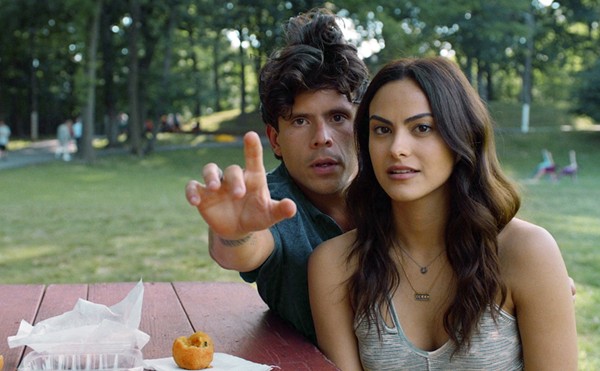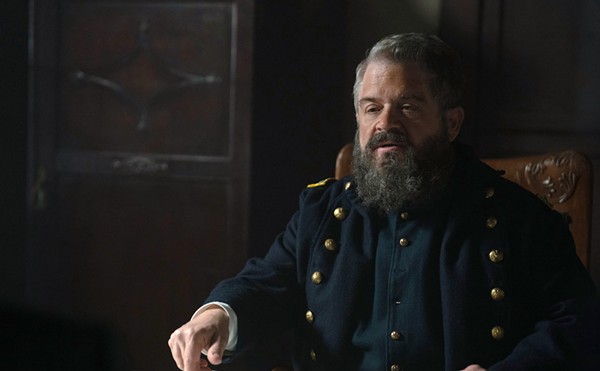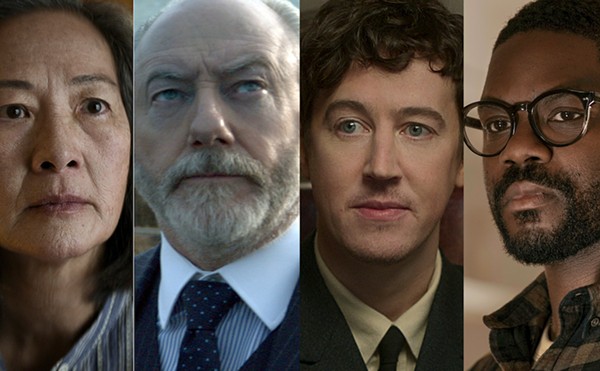Audio-described films fill the gaps for the visually impaired
The Full Monty, an Oscar-winning comedy about six unemployed steelworkers who form a striptease act, relies on sight gags for its punch lines. But why shouldn’t the visually impaired enjoy the characters’ pasty buttocks, knobby knees, and varying lengths of chest hair? In the audio-described version of The Full Monty, they can.
Of the hundreds of major-studio, art, and independent films released in 2005, only 58 came with pre-recorded audio description; the Alamo Quarry Stadium 16 is equipped to show those that have that feature. For films without a pre-recorded track, VSA Arts Texas offers live description at the Mayan Palace Theater. The non-profit group, based in Austin, also describes theatrical productions, opera, dance, and museum collections.
Of the estimated 15,000 San Antonians who are sight-impaired, an average of 18 to 20 people attend an audio-described showing at the Mayan, which, while seemingly insignificant by traditional movie-attendance standards, is considered a large turnout, says VSA’s Mary Torkelson, an audio describer and trainer. “There’s a big demand for it in San Antonio.”
| Resources for audio-described films • Alamo Quarry Stadium 16 (pre-recorded description). Call for showtimes, 804-1115 • Mayan Palace (live description). Call for showtimes, VSA Arts (512) 454-9912 • The San Antonio Library has audio-described films in its collection. Some titles are available on VHS, but DVDs are rarely released with audio-description tracks, and if they are, it’s not listed on packaging. According to WGBH’s National Center for Accessible Media, since 2003 only Daredevil, Road to Perdition (widescreen), Passion of the Christ, Ray, Cinderella Man, Moulin Rouge, and The 40 Year Old Virgin have been released on audio-described DVD. |
Before an audio-described matinee of Harry Potter and the Goblet of Fire at the Mayan Palace, Larry Roser grabs a bite from the snack bar and sits alone at a table, his metal cane tucked underneath it. “When I had partial vision, I had to go to the front of the theater,” says Roser, who was born prematurely and had his left eye removed. Although he once had partial sight in his right eye, he eventually became totally blind. Nonetheless, he graduated from Our Lady of the Lake University with a bachelor’s degree in social work. “I took it in stride.”
In the darkened theater, Roser puts in an earpiece that is connected to a small receiver that picks up the audio signal from the transmitter in the back of the room. “I like to have pictures described, to know where people are standing or moving,” Roser says, adding that if a movie isn’t audio-described, he brings a friend who whispers the action to him. “The description enhances the narration.”
Pre-recorded audio description was invented by Margaret and Cody Phanstiehl in 1981. In 1990, the Media Access Group at Boston public-television station WGBH created the Descriptive Audio Service, a technology that provides narration for feature films. According to the WGBH website, in 1992 the station launched the Motion Picture Access Project to develop ways to make movies accessible to the blind and hearing impaired. Studios contract with WGBH for description services, which run about $9,000, and specially trained describers listen to the film without watching it to approximate the experience of someone with limited or no vision. Using computer software, a describer maps the pauses in the movie and writes the description that will fit in the space. Professional narrators then read the script while watching and listening to the program.
Live description is similar to its pre-recorded counterpart, except describers can’t edit mistakes or re-read parts. Nor is there time to skip out for popcorn or to let your mind wander back to an important plot point. “You have to be so actively engaged,” says audio-describer Laura Goodwin. “Afterward, I’m pretty wiped out.”
In the back of the theater, Goodwin warms up by speaking into a court stenographer’s mask microphone, which resembles a 1970s model telephone fitted with a small cup. To prepare for live description, she watches a movie several times and practices her narration. “You try not to step on the dialogue,” says Goodwin, who trained on the film My Left Foot. “It’s like a game, trying to fit in your words and learning what is important to describe and what to leave out.”
The timbre of a describer’s voice — Roser says a woman’s alto is the most pleasant — and proper enunciation provide clarity, while a voice’s emotion conveys meaning. “Some patrons want a voice that’s more excited; it helps them be excited,” says Goodwin. “But you don’t want to `impose` your interpretation of a movie. I found that dramas are particularly difficult for me because there is so much subtlely and they rely on expression and body language. It’s easier to describe action.”
The film begins, and while the confluence of description and dialogue is initially disconcerting (especially because the trend is for theaters to blast the audio), eventually you grow accustomed to Goodwin’s voice in your ear.
“A long, thin, red scar from his nose to his chin. He has one human leg and one mechanical leg that causes him to limp. He walks with a chunky wooden crutch. He has one regular-sized eye and an oversized left mechanical eye that is attached to his face. A large, blue pupil moves independent of the other eye.”
“The narration is very good and it sounds good,” Roser whispers. He settles in his chair, adjusts the volume, and enjoys the ride.














